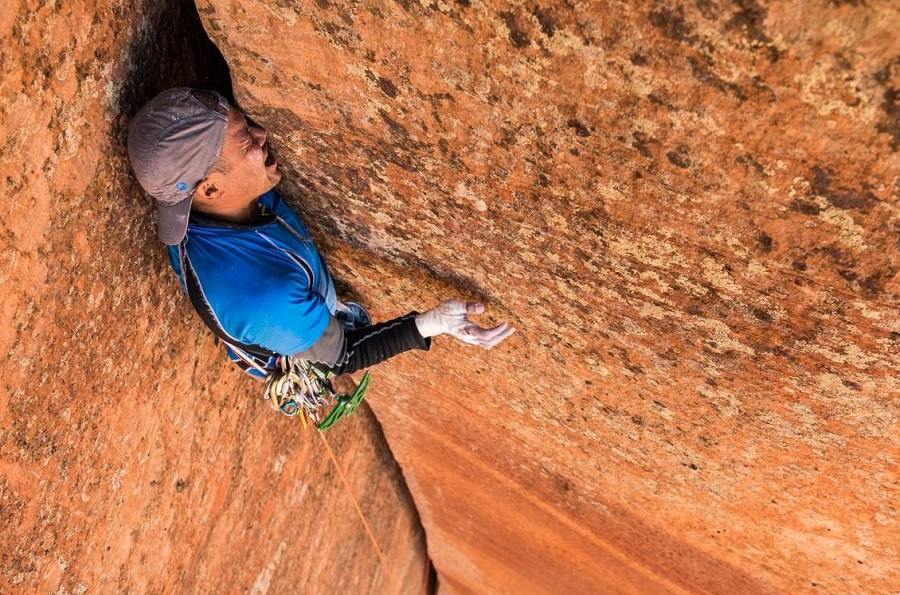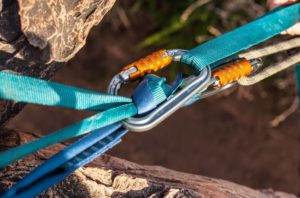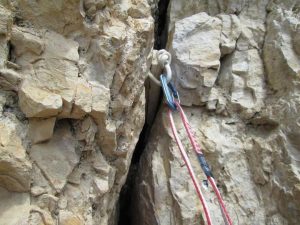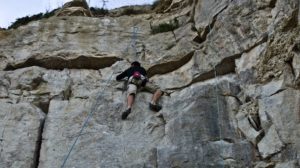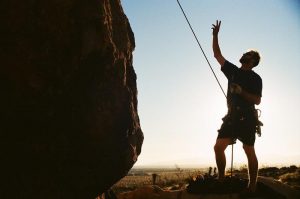Climbing an off-width crack is usually a full-body wrestling match. You versus an evil-sized crack. Off-width cracks are too big to fist jam and too small to fit inside, so they are strenuous, desperate, repetitive, and hard to protect. Climbing an off-width crack requires using every part of your body—ankles, heels, toes, calves, knees, thighs, hips, shoulders, elbows, and arms—to make incremental progress. Heck, some climbers even wedge their heads.
Climb Lots of OWs to Get Good
The best way to climb off-width cracks is to get lots of experience climbing wide cracks. There are no easy shortcuts to becoming a proficient off-width climber. You have to get out there and do them. Find an OW master and follow him up a lot of wide cracks. You will emerge from those days of thrutching and thrashing up wide cracks as an able and maybe even willing off-width crack climber.
Tips to Lead Off-Width Cracks
As an aspiring off-width guru, you will eventually start leading wide cracks. Here are some suggestions to streamline the process and come up with a workable strategy to efficiently and safely climb those bad boys.
Slim Down the Harness
Slim down the harness. Harnesses, especially those used on long routes and big walls, are usually bulky with a thick waist belt, beefy leg loops, and a bunch of gear loops. All those bulky items catch and pull and grab inside an off-width crack. They slow you down and they can spit you out of the crack. If you are going to climb some off-widths, especially at places like Indian Creek, then wear a slimmed-down harness like one of those low-profile sport climbing harnesses. They fit you like a glove and keep you moving upward.
Where’s the Knot?
Where’s the knot? Okay, you are wearing an anorexic harness but that tie-in knot, usually a figure-8 follow-through knot, is bulky and grabs the edge of the crack every time you try to slither up. Unfortunately, there is not much you can do about the knot. You have to be tied in. Try using a thinner diameter rope than you usually do on a long route, like a 9mm rope rather than a 10.3mm one. When you tie the knot, lay all the strands perfectly and tighten it down. Another trick I use on tight off-width cracks is to tie the knot so it hangs down between my lower thighs rather than at my waist. As I climb, the tie-in knot is less likely to scrape and pull and grab.
Rack Gear on a Sling
Rack gear on a sling. To efficiently climb off-widths, rack all your cams, carabiners, and quickdraws on a shoulder sling. The worst thing is to have them on the gear loops on your harness. If they are on your harness, you’re guaranteed to struggle as they snag inside the crack. And once you’re climbing, you can’t switch them to the opposite side. Remember that off-width cracks are climbed either right-side in or left-side in; sometimes you may even switch sides part-way up the crack. If you rack all your gear on a shoulder sling, then it is easier to shift the gear from side to side.
Don’t Carry a Full Rack
Don’t carry a full rack. If you’re leading a long off-width crack, then you need a lot of gear to protect it. That gear, however, is usually a combination of giant cams and Big Bros. Both are bulky, take up a lot of room on your gear sling, and again, catch and snag and slow you down. The good thing is that most off-width cracks vary in size; they will usually open into wider sections or pods where you can rest. Use a thin haul line, clipped to the outside loop of your harness, and pull up the extra gear that you need from the rest stance. Before you lead the pitch, strategize ahead and figure out what you need for each section between rests.
Slide Big Cams Up
Slide big cams up. As you lead an off-width crack, slide a big cam up as you climb. That way you are always protected. Sometimes it seems like you always have a top-rope above you. Remember to place cams and Big Bros as you progress though. In sandstone cracks, like those around Moab or Indian Creek, place protection every 10 or 12 feet since cams can walk out of the cracks or even pull out if you fall. Also consider using Big Bros whenever you can. They take up less room on your rack and, with practice, are not that hard to place.
Use Retaining Pins on Big Cams
Use retaining pins on big cams. Big cams are, well, they’re big and bulky and stick out so they can stick on everything. Use a retaining pin to slide through holes in the cam to lessen its profile. Some climbers make their own by cutting a piece of clothes hanger, making an eye at the end with pliers, and attaching a short cord to tie it to the cam. You can improvise on the spot by using a stout twig.

